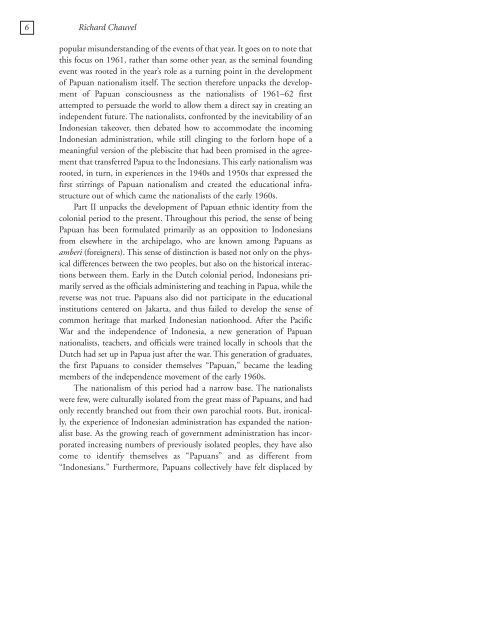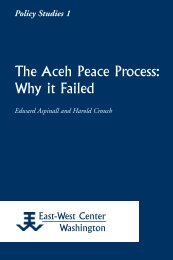Constructing Papuan Nationalism: History, Ethnicity ... - ScholarSpace
Constructing Papuan Nationalism: History, Ethnicity ... - ScholarSpace
Constructing Papuan Nationalism: History, Ethnicity ... - ScholarSpace
- No tags were found...
Create successful ePaper yourself
Turn your PDF publications into a flip-book with our unique Google optimized e-Paper software.
6 Richard Chauvelpopular misunderstanding of the events of that year. It goes on to note thatthis focus on 1961, rather than some other year, as the seminal foundingevent was rooted in the year’s role as a turning point in the developmentof <strong>Papuan</strong> nationalism itself. The section therefore unpacks the developmentof <strong>Papuan</strong> consciousness as the nationalists of 1961–62 firstattempted to persuade the world to allow them a direct say in creating anindependent future. The nationalists, confronted by the inevitability of anIndonesian takeover, then debated how to accommodate the incomingIndonesian administration, while still clinging to the forlorn hope of ameaningful version of the plebiscite that had been promised in the agreementthat transferred Papua to the Indonesians. This early nationalism wasrooted, in turn, in experiences in the 1940s and 1950s that expressed thefirst stirrings of <strong>Papuan</strong> nationalism and created the educational infrastructureout of which came the nationalists of the early 1960s.Part II unpacks the development of <strong>Papuan</strong> ethnic identity from thecolonial period to the present. Throughout this period, the sense of being<strong>Papuan</strong> has been formulated primarily as an opposition to Indonesiansfrom elsewhere in the archipelago, who are known among <strong>Papuan</strong>s asamberi (foreigners). This sense of distinction is based not only on the physicaldifferences between the two peoples, but also on the historical interactionsbetween them. Early in the Dutch colonial period, Indonesians primarilyserved as the officials administering and teaching in Papua, while thereverse was not true. <strong>Papuan</strong>s also did not participate in the educationalinstitutions centered on Jakarta, and thus failed to develop the sense ofcommon heritage that marked Indonesian nationhood. After the PacificWar and the independence of Indonesia, a new generation of <strong>Papuan</strong>nationalists, teachers, and officials were trained locally in schools that theDutch had set up in Papua just after the war. This generation of graduates,the first <strong>Papuan</strong>s to consider themselves “<strong>Papuan</strong>,” became the leadingmembers of the independence movement of the early 1960s.The nationalism of this period had a narrow base. The nationalistswere few, were culturally isolated from the great mass of <strong>Papuan</strong>s, and hadonly recently branched out from their own parochial roots. But, ironically,the experience of Indonesian administration has expanded the nationalistbase. As the growing reach of government administration has incorporatedincreasing numbers of previously isolated peoples, they have alsocome to identify themselves as “<strong>Papuan</strong>s” and as different from“Indonesians.” Furthermore, <strong>Papuan</strong>s collectively have felt displaced by
















